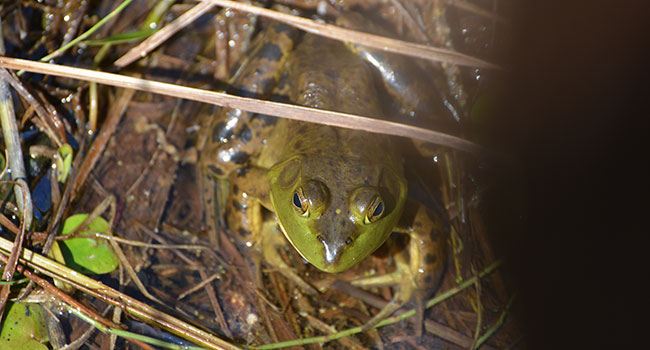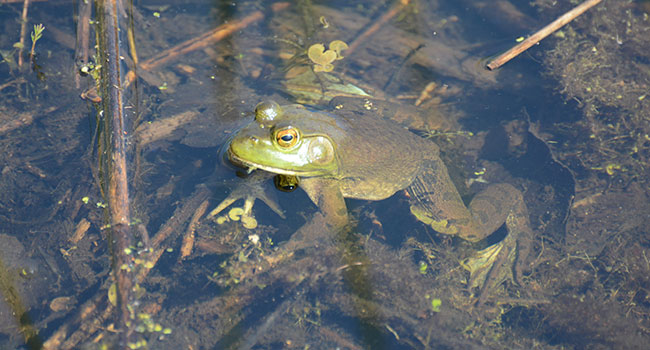
Many of our aquatic frogs hibernate underwater but aren’t buried in the mud as many sources report. Rather, they lie on the bottom of a pond or lake
 Man, it’s cold out there! I wonder where the snakes and turtles are?
Man, it’s cold out there! I wonder where the snakes and turtles are?
They can’t migrate so they must be here somewhere.
Reptiles such as turtles, lizards and snakes, like so many other animals, have to survive our cold, long winters. Generally, they go underwater or underground and hibernate … or do they?
They do assuredly use aquatic and subterranean habitats but they don’t actually hibernate – instead, they go through brumation.
Hibernation is when animals go into deep continual physiological sleep.
Brumation is similar to hibernation, but it differs in that brumating amphibians and reptiles (collectively called herptiles) lower their metabolic and heart rates, but remain mostly conscious and sometimes are even active. Snakes will occasionally come out of their hibernacula (i.e. underground overwintering places) and sun themselves on bright days and turtles may be seen swimming under the ice once in a while.
Preparing for winter, most reptiles eat heartily for a while, then stop feeding shortly before they brumate, so the food can be digested and turned into fat for storage. Their metabolic rate is so low that they can fast for months until spring, when they resume feeding.
Unlike mammals, reptiles also build up large reserves of glycogen, a sugar they use to feed their muscles. Unlike in mammals, their stored fat seems to be reserved to assist them with egg development and reproduction, once they emerge from brumation.
Breathing in the winter, however, can be tricky. Snakes that stay underground are fine as the hibernacula are not airtight. But what does a turtle living underwater do?
The turtle can extract oxygen directly from the water through its cloaca (sort of like their bum). The stored glycogen in their blood assists them in tolerating lower oxygen levels, which is obviously beneficial as they live in an oxygen-poor environment.
Reptiles must drink during brumation or they will dehydrate, whereas mammals don’t need to drink water to survive hibernation. Reptiles must also regulate their body temperature as they’re cold-blooded (i.e. ectothermic).
Reptiles need to determine when they need to slow down their metabolic, circulatory and respiratory rates. The timing is critical – if they start too soon they may not survive a prolonged cold and if they start too late, it might be too late.
The cues on when to start come from two sources: endogenous cues (e.g. hormones and circadian rhythms) come from within the animal and exogenous cues (e.g. photoperiod, barometric pressure, temperature and humidity) come from the environment in which the reptile lives.
Many of our aquatic frogs hibernate underwater but aren’t buried in the mud as many sources report. Rather, they lie on the bottom of a pond or lake, either fully exposed or only partially buried. Due to their physiological processes, they would suffocate if totally buried as they can’t extract oxygen from the substrate the way a turtle can.
Terrestrial frogs (such as the American toad) dig deeply (below the frost line) into the soil to overwinter. Other terrestrial frogs, such as the spring peeper and wood frog, aren’t good diggers so will often hide in crevices and under logs and leaf litter, freezing solid for the winter.
Overwintering frogs, like the reptiles, store large amounts of glycose in their blood, which prevents vital organs from freezing, even though much of the animal is in fact frozen solid (bladder, body cavity and the skin). Uric acid is combined inside the body with glycogen to reduce the potential of freezing the organs by limiting the amount of ice that can form inside the frog’s cells.
So the tissues and non-vital organs can freeze, but the important cells and organs remain unfrozen. When it thaws, the heart resumes beating and respiration commences, the frog revives and these amazing life processes resume.
Get ready – these amazing critters will become active soon. I can’t wait to hear my first spring peepers calling from the wetland behind my home.
Geoff Carpentier is a published author, expedition guide and environmental consultant. Visit Geoff online at www.avocetnatureservices.com, on LinkedIn and on Facebook.
For interview requests, click here. You must be a Troy Media Marketplace media subscriber to access our Sourcebook.
The views, opinions and positions expressed by columnists and contributors are the author’s alone. They do not inherently or expressly reflect the views, opinions and/or positions of our publication.

